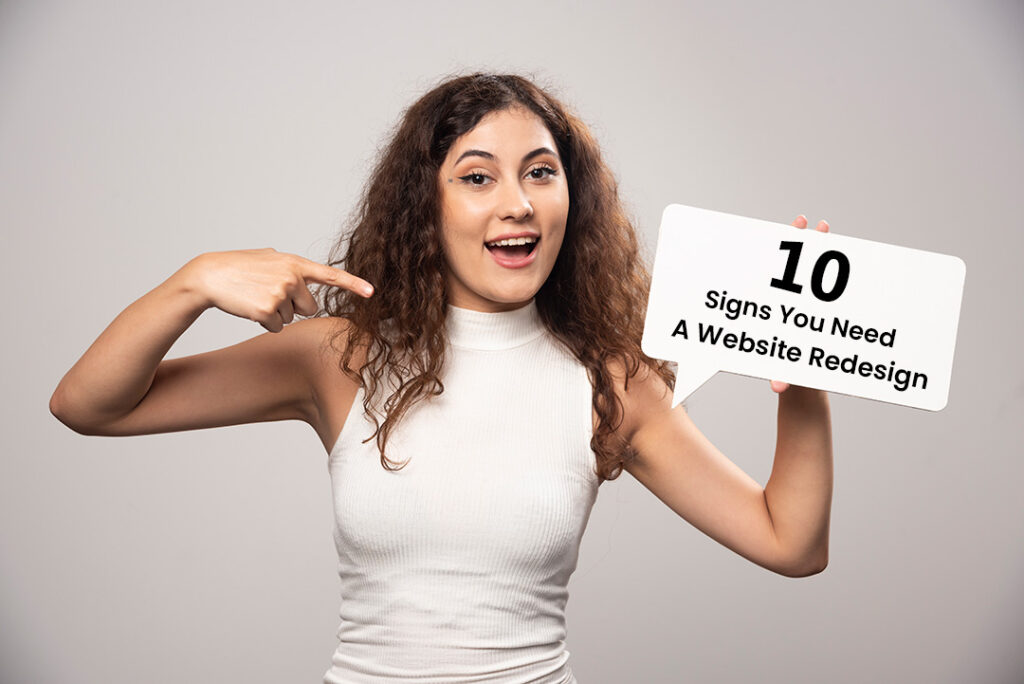When was the last time you looked at your own website — really looked at it — through the eyes of a potential customer? If your business has grown, your style has evolved, or your services have changed, but your site still looks and feels the same as it did years ago… it might be time for a website redesign.
Your website is more than just a digital brochure. It’s your brand’s online home — the first impression many people will have of your business. Especially in today’s world, where modern websites set the standard for credibility and trust, having an outdated or confusing site can quietly work against you.
That first impression happens fast — studies show users form an opinion about your website in just 0.05 seconds. If your site looks outdated or doesn’t align with your brand voice, that moment may be enough to lose someone’s trust. And trust is everything online. People won’t always say, “This site feels off,” but they’ll bounce, hesitate to buy, or never return. Your website should not only look good — it should feel like you. Clean, easy to navigate, and accurate to your brand story. That’s what keeps visitors around and turns them into customers.

10 Real Signs Your Website Might Be Holding Your Brand Back
Not sure if it’s time to make a change? You’re not alone — many business owners get so focused on growth, products, and social media that the website becomes an afterthought. But here’s the thing: your website is still your digital home. And if that home feels outdated, messy, or unwelcoming, it may quietly be pushing people away.
Let’s break down 10 clear, real-world signs that your site could be due for a redesign — and what each one means for your brand.
1. Your Website Looks Outdated
Design trends change — and fast. If your website looks like it was built in 2014, visitors may assume your business hasn’t evolved either. Harsh shadows, cluttered layouts, tiny text, or outdated fonts can all create the impression that your business is stuck in the past.
Think about it this way: would you walk into a boutique with peeling paint, flickering lights, and dusty shelves? Probably not. That’s how users feel when they land on an old-looking site. A modern website design feels fresh, clean, and relevant — and tells your audience, “We care about quality.”
2. It Doesn’t Match Your Brand Identity
Your brand is more than a logo — it’s the mood, message, and energy you put into the world. If your website doesn’t match your tone, colors, or visual personality across platforms (especially your socials), your audience feels the disconnect.
Example: If your Instagram feed is filled with warm tones, personal stories, and approachable captions — but your site feels stiff and corporate — trust drops. A website redesign brings everything into alignment so people feel the same energy no matter where they engage with you.
3. It’s Not Mobile-Friendly
Over half of all website traffic now comes from mobile devices. That means your site needs to look just as good — and function just as smoothly — on a phone as it does on a desktop.
If users have to pinch and zoom, squint to read text, or struggle to tap a button, they’re gone. A good small business website design starts with mobile in mind. That means clear menus, readable fonts, fast loading, and click-friendly buttons on every screen size.
4. Navigation Is Confusing or Overloaded
Can someone find your pricing in one click? Do they know where to go next after reading your homepage? If not, your navigation may be working against you.
Confusing menus, endless dropdowns, broken links, or hidden CTAs frustrate visitors. And frustrated people don’t stick around. Your website should guide people, not overwhelm them. A smart redesign simplifies your site’s structure so that users find what they need fast — without thinking too hard.
5. Your Content Doesn’t Speak to Your Audience
Let’s face it: many websites are filled with “We do this” and “Our company was founded in…” — but none of that really answers the visitor’s question: “What’s in it for me?”
Today’s content needs to be clear, empathetic, and benefit-driven. Instead of saying “We offer professional landscaping services,” say “We help homeowners create beautiful outdoor spaces they love coming home to.” A redesign is the perfect time to refresh your tone, simplify your message, and speak directly to your ideal client.
6. You’re Using Low-Quality Images or Generic Stock
Your visuals are just as important as your words. If your website relies on blurry photos or stock images that could belong to anyone, it becomes harder for people to trust that your business is the real deal.
Even a few high-quality photos of your team, product in action, or behind-the-scenes moments can make a huge difference. A redesign lets you rethink your imagery and choose visuals that reflect your personality — not someone else’s.
7. Load Time Is Slow
Speed kills — but in this case, it’s slow speed that kills your user experience. If your site takes more than 3 seconds to load, most visitors won’t stick around.
Things like oversized images, outdated code, and heavy plugins can drag your site down. A good redesign focuses on performance just as much as aesthetics. That means optimizing images, cleaning up your backend, and making sure your site runs smoothly — especially on mobile.
8. You’re Getting Traffic but No Conversions
You’ve got visitors. You’ve got traffic. But… no one’s clicking that “Book Now” button or filling out the contact form. That’s a problem.
It often means your site looks nice, but the content, layout, or call-to-action isn’t clear or convincing. A strong website redesign refines the path from interest to action — helping turn those passive views into real results. Whether it’s booking a service, scheduling a consult, or purchasing a product, your site should lead users to take the next step.
9. Your Website Doesn’t Reflect Your Current Goals
Businesses evolve. Maybe you’ve shifted your focus, raised your prices, added new services, or narrowed your niche. If your website still speaks to the old version of your business, it’s not helping you grow.
Your site should support your future, not just represent your past. If you’re positioning yourself as a premium service, but your site still feels DIY, you’re sending mixed signals. A redesign brings your goals, audience, and messaging into alignment.
10. You’re Embarrassed to Share It
This one is surprisingly common — and deeply telling. If you hesitate before dropping your link in a DM, or you avoid mentioning your site altogether, that’s a huge red flag.
Your website should be something you’re proud to share — a place where people can clearly see what you offer and why it matters. If you’re making excuses like “It’s not finished” or “I know it’s not great right now,” it’s time for change. A clean, modern website gives you confidence — and helps you make stronger first impressions every time.
Why a Website Redesign Matters More Than You Think
Your website isn’t just a place to list your services — it’s often the first and only chance to make a real impression. Whether someone finds you through a Google search, clicks on a Facebook ad, or taps the link in your Instagram bio, they’re headed straight to your site to decide if you’re worth their time.
And that decision happens fast.
If your site looks polished, matches your brand’s voice, and is easy to navigate, people stick around. They explore. They start to trust you. But if your site feels clunky, off-brand, or outdated, most visitors won’t give it a second thought — they’ll bounce and move on to someone who “feels” more aligned with what they’re looking for.
For small businesses especially, investing in a solid small business website design is more than a design upgrade. It’s a credibility boost. It’s the difference between being seen as a side hustle vs. a serious business. It helps you look as good online as you are in real life — and that alignment is where the magic happens.
What to Do If You See These Signs
If those 10 signs hit a little too close to home, take a deep breath — you’re not behind. You’re evolving. And a website redesign is simply part of keeping your brand aligned with where you’re headed.
Here’s a simple checklist to get you started:
- Run a mobile check on your site
Visit your website from your phone. Are the fonts readable? Do buttons work? Is it easy to scroll and tap? If not, it’s a clear sign that your mobile experience needs work — and today’s users won’t wait around for you to fix it later. - Compare your homepage tone to your Instagram voice
Is your homepage stiff and formal while your Instagram is casual, warm, or funny? That inconsistency may confuse visitors. Your tone across platforms should feel cohesive so your audience knows exactly who they’re dealing with. - Ask a friend (or a trusted customer) to navigate your site
Choose someone who’ll be honest. Ask them to find a specific service, contact form, or product. Watch how long it takes them and where they get stuck. Their struggle spots are your redesign opportunities. - Check your load speed using GTmetrix or Google PageSpeed Insights
A beautiful website means nothing if it loads like it’s stuck in 2008. Use free tools to test your performance — and if your scores are in the red, it’s a clear technical signal for change. - Create a “must-have” list for your redesign
What are the core goals of your site? Bookings? Conversions? Education? Make a short list before redesigning, so every decision you make supports those goals.
When you’re ready to move forward, consider working with a team who not only understands clean design — but who also understands how to build modern websites that convert. Your website shouldn’t just look pretty. It should work.
Final Thoughts
A website redesign isn’t just a facelift — it’s a growth move. It’s a chance to realign your visuals, message, and user experience with the brand you’ve become.
When your site reflects who you are — confidently and clearly — something shifts. You stop cringing when people ask for your link. You start booking better-fit clients. You convert more visitors because they finally get you.
So if your current site isn’t pulling its weight, trust the signs.
And remember: You don’t need perfect. You just need a website that finally feels like you.
Need help bringing your brand to life online?
At Brandifies, we help small businesses turn outdated websites into powerful digital experiences — aligned with who you are and what you’re building.
Let’s create a site that works as hard as you do.


